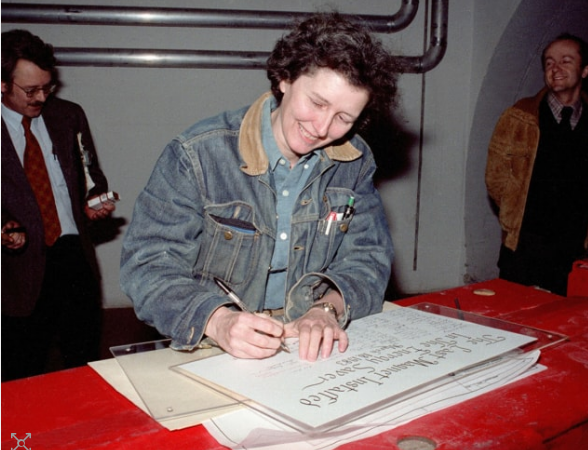Insider Brief
- Researchers discovered that highly disordered superconductors, such as indium oxide films, undergo abrupt first-order quantum phase transitions, challenging traditional theories that assume gradual transitions.
- The findings, which reveal a sharp drop in superfluid stiffness at a critical disorder level, have significant implications for quantum computing, particularly in designing stable superconducting circuits and superinductors.
- The study highlights the need to revisit existing models of quantum phase transitions and explore how disorder influences superconductivity in other materials.
Researchers have discovered that certain disordered superconductors exhibit abrupt phase transitions, a finding that challenges established theories and could have implications for quantum computing.
A study published in Nature by researchers investigating indium oxide films — a highly disordered superconductor — shows that their transition from a superconducting to an insulating state is not gradual, as traditionally assumed, but sudden. This abrupt shift, known as a first-order quantum phase transition, contrasts with the commonly observed continuous, second-order transitions in superconductors.
Key measurements revealed a sharp drop in superfluid stiffness — which is a property that reflects the superconducting state’s ability to resist phase distortions — at a critical level of disorder. Interestingly, the critical temperature of these films, where superconductivity breaks down, no longer depended on the strength of electron pairing but rather on the superfluid stiffness. This behavior aligns with a pseudogap regime, where electron pairs exist but lack the coherence needed for superconductivity.

“This discontinuous transition sheds light on the role of repulsive interactions between Cooper pairs and the subsequent competition between superconductivity and insulating Cooper-pair glass,” the researchers write in the study. “Furthermore, we show that the critical temperature of the films no longer relates to the pairing amplitude but aligns with the superfluid stiffness, consistent with the pseudogap regime of preformed. Our findings raise fundamental new questions about the role of disorder in quantum phase transitions and carry implications for superinductances in quantum circuits.”
Integral to Quantum Computing
The study has direct implications for quantum computing hardware, particularly in the design of superconducting circuits. Superconductors are integral to quantum computers, providing the foundation for qubits and components like superinductors. The observed sudden phase transitions could inform how materials are engineered to improve the stability and performance of quantum systems.
Materials with low superfluid stiffness but retained Cooper pair formation, like those in the study, could also help create more efficient superinductors. These are needed for shielding qubits from external disturbances and enhancing coherence times, which are vital for practical quantum computing applications.
Controlling Fabrication Conditions
The researchers studied amorphous indium oxide thin films, tuning their level of disorder by controlling their fabrication conditions. The team employed advanced microwave spectroscopy to measure the plasmon spectrum of superconducting resonators fabricated from these films. These measurements allowed precise extraction of the superfluid stiffness and its behavior under increasing disorder.
They observed that as disorder increased, the superfluid stiffness showed an unexpected abrupt drop instead of the gradual decline predicted by existing theories. This jump signaled a breakdown in macroscopic coherence, marking the transition from a superconducting to an insulating state.
Limitations
While the study provides compelling evidence of a first-order transition, it raises new questions about the underlying mechanisms. The role of repulsive interactions between Cooper pairs and the emergence of a localized Cooper-pair glass—a state where electron pairs are immobilized—are not fully understood. Further investigation into the microscopic details of these interactions is necessary to develop comprehensive theories.
The research was also limited to indium oxide, a specific type of disordered superconductor. Whether similar transitions occur in other materials remains an open question.
Future Directions
The findings highlight the need to revisit established models of quantum phase transitions, particularly in disordered systems. Future work could explore the applicability of these results to other superconductors and investigate the interplay between material properties, disorder, and quantum phenomena.
The study also underscores the potential for developing novel quantum circuit components. Superinductors, for instance, could benefit from a deeper understanding of how disorder influences superfluid stiffness and phase transitions.
Researchers and Institutions
This study was conducted by Thibault Charpentier, David Perconte, Sébastien Léger, Kazi Rafsanjani Amin, Florent Blondelle, Frédéric Gay, Olivier Buisson, Nicolas Roch, and Benjamin Sacépé from Université Grenoble Alpes, CNRS, Grenoble INP, Institut Néel; Lev Ioffe from Google Research, USA; Anton Khvalyuk and Mikhail Feigel’man from LPMMC, Université Grenoble Alpes; Igor Poboiko from Karlsruhe Institute of Technology; and Mikhail Feigel’man additionally affiliated with the CENN Nanocenter and the Jožef Stefan Institute.


















